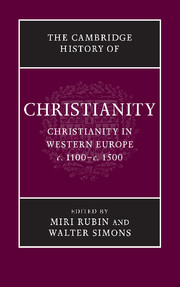Book contents
- Frontmatter
- Introduction
- PART I INSTITUTIONS AND CHANGE: 1100–1200
- PART II FORGING A CHRISTIAN WORLD, 1200–1300
- PART III THE ERECTION OF BOUNDARIES
- 10 Christians and Jews
- 11 Christendom and Islam
- 12 Christians and heretics
- 13 Women and men
- 14 Heaven, hell and purgatory: 1100–1500
- PART IV SHAPES OF A CHRISTIAN WORLD
- PART V CHRISTIAN LIFE IN MOVEMENT
- PART VI THE CHALLENGES TO A CHRISTIAN SOCIETY
- PART VII REFORM AND RENEWAL
- Select bibliography
- Index
- Map 1 Western Europe c. 1100 – c. 1500
- Map 2 Universities of Europe
- References
10 - Christians and Jews
from PART III - THE ERECTION OF BOUNDARIES
Published online by Cambridge University Press: 28 March 2010
- Frontmatter
- Introduction
- PART I INSTITUTIONS AND CHANGE: 1100–1200
- PART II FORGING A CHRISTIAN WORLD, 1200–1300
- PART III THE ERECTION OF BOUNDARIES
- 10 Christians and Jews
- 11 Christendom and Islam
- 12 Christians and heretics
- 13 Women and men
- 14 Heaven, hell and purgatory: 1100–1500
- PART IV SHAPES OF A CHRISTIAN WORLD
- PART V CHRISTIAN LIFE IN MOVEMENT
- PART VI THE CHALLENGES TO A CHRISTIAN SOCIETY
- PART VII REFORM AND RENEWAL
- Select bibliography
- Index
- Map 1 Western Europe c. 1100 – c. 1500
- Map 2 Universities of Europe
- References
Summary
The term ‘boundary’ in reference to Jews is a complex one. Like Muslims, Jews were outside the Christian faith but, unlike the Muslims, they were present within Christian society. Like heretics, Jews were present in Christian society but, unlike them, they were not perceived as a part of the body of faith. These three groups represent three disparate types of boundaries, each determining a different attitude towards the group defined by the boundary. Yet, the Christian world did not view these groups as completely distinct from one another, and its attitude towards each carried over to its treatment of the other groups. In this way, the crusades, explicitly declared against the Muslims - the enemies of the church in foreign lands – influenced and aggravated the treatment of the enemies within Christian lands – the Jews. Similarly, the intensive campaign against heretical sects initiated in the thirteenth century led to the erection of sturdier barriers between Christians and Jews.
In addition, the Jew figures in the Christian world on two levels – one physical and the other theological – and the two are not fully congruent. The theological (or hermeneutical) Jew is present in Christian imagination and thought; the Jew forms an integral part of the Christian worldview as an internal entity bearing unvarying characteristics, and this perception also dictates the attitude towards living Jews. Moreover, even when ‘real’ Jews are absent from Christian society, in spite of their absence they continue to function as an internal, imagined ‘other’.
Keywords
- Type
- Chapter
- Information
- The Cambridge History of Christianity , pp. 133 - 148Publisher: Cambridge University PressPrint publication year: 2009



